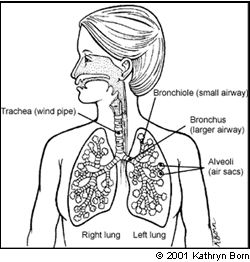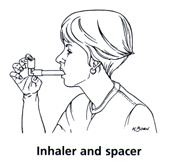Asthma is a chronic, or long-term, disease. If you have asthma, at times your airways (the air passages of your lungs) become inflamed (see picture). When this happens, your airways get red and swollen. They become narrow, making it harder for you to breathe. You may also wheeze or cough. This is called an asthma flare-up (or "attack"). Even when you feel good, your airways can be inflamed. Certain things, such as smoke or dust, can start or trigger an asthma attack.
Asthma: Controller and Quick-Relief Medicine
What is asthma?

How is asthma treated?
Most people with asthma take 2 kinds of medicines. One kind is called controller medicine. These medicines help control the inflammation so you feel and breathe better. They stop your airways from reacting to what triggers your asthma. Controller medicines work only if you take them every day, as your doctor tells you.
Another kind of asthma medicine is quick-relief or rescue medicine (also called bronchodilators). These medicines dilate the airways (make them bigger) and make it easier for you to breathe. These inhaled medicines should only be used for quick relief when you are coughing or wheezing, or when your chest feels tight.
Another kind of asthma medicine is quick-relief or rescue medicine (also called bronchodilators). These medicines dilate the airways (make them bigger) and make it easier for you to breathe. These inhaled medicines should only be used for quick relief when you are coughing or wheezing, or when your chest feels tight.
Controller and Quick-Relief Medicines
These are some of the medicines most commonly used by people with asthma:
Controller Medicines
- Inhaled corticosteroids (some brand names: AeroBid, Azmacort, Flovent, Pulmicort, Vanceril, etc.)
- Cromolyn (brand name:Intal)
- Nedocromil (brand name: Tilade)
- Anti-leukotrienes (some brand names: Accolate, Singulair, Zyflo)
- Theophylline (some brand names: Slo-bid, Theo-Dur, Theo-24, Uni-Dur)
- Serevent (inhaled long-acting beta2 agonist)
Quick-Relief Medicines
- Albuterol, Pirbuterol, Levalbuterol or Bitolterol (inhaled short-acting beta2 agonist)
- Atrovent (anticholinergic)
- Prednisone, prednisolone (oral steroids)
How safe are controller medicines for asthma?
Controller medicines for asthma are safe to use every day. You will not become addicted to these medicines even if you use them for many years.
Your doctor may tell you to take controller medicine every day if:
Your doctor may tell you to take controller medicine every day if:
- You cough, wheeze or have a tight chest more than once a week.
- You wake up at night because of asthma.
- You have many asthma attacks.
- You have to use quick-relief medicine every day to stop asthma attacks.
How should I use my quick-relief medicine?
Quick-relief medicine for asthma makes you feel better for a while. It may stop the attack. With some attacks, you may think you are getting better but the airways are getting more and more swollen. Then you are in danger of having a very bad asthma attack that could kill you.
If you use quick-relief medicine every day to stop asthma attacks, this means you need a preventive medicine for long-term control.
If you use quick-relief medicine every day to stop asthma attacks, this means you need a preventive medicine for long-term control.
How can I control my asthma?
You can follow this easy 4-step program.
Step 1: Avoid, or try to control exposure to, anything that you know triggers your asthma or makes it worse. These triggers may include:
Step 1: Avoid, or try to control exposure to, anything that you know triggers your asthma or makes it worse. These triggers may include:
- Air pollution, tobacco smoke, perfume or other irritants
- Allergens such as pet dander, pollen, dust and mold
- Infections (get a flu shot every year and avoid people who have a cold)
Step 2: Take your controller medicines every day.
- Most of the controller medicines need to be taken once or twice daily.
- If you have symptoms of asthma more than twice a week or if you wake up during the night with symptoms of asthma more than twice a month, your asthma is not under control. Ask your family doctor to help you get your asthma under control. Then, do your part and take your medicines regularly.
Step 3: Be prepared. Always have asthma medicine.
- Always carry your quick-relief asthma medicine with you when you leave home. Follow the instructions in the picture below.
Step 4: Act fast if an asthma attack starts. Know the signs that an asthma attack is starting:
- Coughing
- Wheezing
- Tight chest
- Waking up at night
If you know what started the attack, avoid it if you can. Use your quick-relief asthma medicine. Stay calm for 1 hour to be sure breathing gets better.
How to Use a Spray Inhaler
Without a spacer
- Take off the cap. Shake the inhaler.
- Stand up. Breathe out.
- Put the inhaler in your mouth or put it just in front of your mouth. As you start to breathe in, push down on the top of the inhaler and keep breathing in slowly.
- Hold your breath for 10 seconds. Breathe out.
With a spacer
A spacer, or a holding chamber, makes it easier to use a spray inhaler.
- Put the open end of the spacer in your mouth.
- Spray the asthma medicine into the spacer one time.
- Take a deep breath and hold it for 10 seconds.
- Breathe out into the spacer.
- Breathe in again, but do not spray the asthma medicine.

What if I don't get better?
Get emergency help from your doctor if you do not get better. Call your doctor or seek emergency care if you see any of the following asthma danger signs:
- Your quick-relief medicine does not help for very long or it does not help at all.
- Breathing is still fast and hard.
- It is hard to walk or talk.
- Lips or fingernails turn gray or blue.
- Your nose opens wide when you breathe.
- Skin is pulled in around the ribs and neck when you breathe.
- Your heartbeat or pulse is very fast.
Some information adapted from "What you and your family can do about asthma," a patient information booklet published by the Global Initiative for Asthma, a joint effort of the National Heart, Lung, and Blood Institute and the World Health Organization. This and other publications are available through the Internet (http://www.ginasthma.com).
Other Organizations
-
American Academy of Allergy, Asthma and Immunology
http://www.aaaai.org
800-822-2762
-
Revolution Health Asthma Community
http://www.revolutionhealth.com/forums/asthma-allergies
Source
Written by familydoctor.org editorial staff.
Management of Asthma in Children by JP Kemp, M.D. and JA Kemp, D.O. (American Family Physician April 1, 2002, http://www.aafp.org/afp/20010401/1341.html)
Reviewed/Updated: 01/08
Created: 09/00
